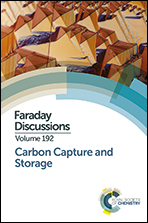A low-energy chilled ammonia process exploiting controlled solid formation for post-combustion CO2 capture†
Abstract
A new ammonia-based process for CO2 capture from flue gas has been developed, which utilizes the formation of solid ammonium bicarbonate to increase the CO2 concentration in the regeneration section of the process. Precipitation, separation, and dissolution of the solid phase are realized in a dedicated process section, while the packed absorption and desorption columns remain free of solids. Additionally, the CO2 wash section applies solid formation to enable a reduction of the wash water consumption. A rigorous performance assessment employing the SPECCA index (Specific Primary Energy Consumption for CO2 Avoided) has been implemented to allow for a comparison of the overall energy penalty between the new process and a standard ammonia-based capture process without solid formation. A thorough understanding of the relevant solid–solid–liquid–vapor phase equilibria and an accurate modeling of them have enabled the synthesis of the process, and have inspired the development of the optimization algorithm used to screen a wide range of operating conditions in equilibrium-based process simulations. Under the assumptions on which the analysis is based, the new process with controlled solid formation achieved a SPECCA of 2.43 MJ kgCO2−1, corresponding to a reduction of 17% compared to the process without solid formation (with a SPECCA of 2.93 MJ kgCO2−1). Ways forward to confirm this significant improvement, and to increase the accuracy of the optimization are also discussed.
- This article is part of the themed collection: Carbon Capture and Storage

 Please wait while we load your content...
Please wait while we load your content...